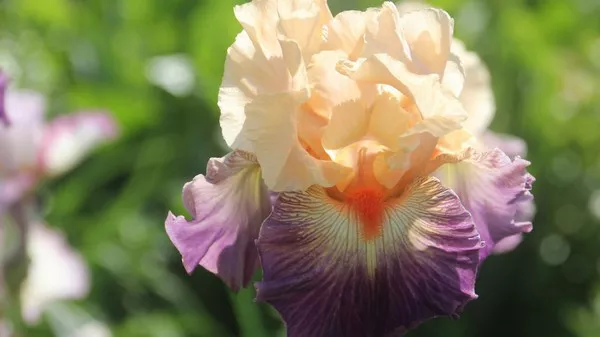The iris flower, with its intricate and elegant petals, has long captured the imagination of artists, poets, and admirers of the natural world. Beyond its aesthetic appeal, the iris holds a wealth of symbolic meanings that have evolved over centuries and across various cultures. This article delves into the depths of the iris’s significance, exploring its diverse interpretations, cultural connotations, and the role it plays in art and literature.
The Iris Flower’s Varied Meanings
The iris flower, also known as the “fleur-de-lis,” boasts a rich tapestry of meanings that have been woven into the fabric of human history and expression. These meanings often transcend mere aesthetics, carrying deeper messages and emotions:
1. Elegance and Beauty: The iris’s exquisite form and delicate hues have led it to be associated with elegance and beauty. Its graceful petals and vibrant colors make it a popular choice for gardens, floral arrangements, and artistic endeavors.
2. Communication and Messages: In the Victorian language of flowers, the iris was a symbol of communication and messages. The unique patterns on the iris’s petals were thought to resemble coded messages, allowing individuals to convey sentiments that couldn’t be expressed aloud.
3. Wisdom and Knowledge: The word “iris” is derived from the Greek goddess Iris, who was believed to be the messenger between the gods and humans. As such, the iris has come to symbolize wisdom, knowledge, and communication between different realms.
4. Hope and Promise: With its appearance in various colors and the promise of a new bloom each year, the iris is often associated with hope and the anticipation of better days to come.
Cultural Connections and Symbolism
The iris’s symbolism extends beyond its inherent traits to encompass cultural associations that have been cultivated through time and geography:
1. Ancient Egypt: The iris held significance in ancient Egyptian culture as a symbol of renewal and resurrection. It was often linked to the life-giving floods of the Nile River and was placed on the chests of the deceased to guide them to the afterlife.
2. Greek Mythology: In Greek mythology, the iris was linked to the goddess Iris, who personified the rainbow and served as a messenger between the gods and mortals. The iris flower’s name pays homage to this divine figure.
3. Heraldry and Royalty: The fleur-de-lis, a stylized representation of the iris, has been a prominent motif in heraldry and royal emblems. It is associated with notions of nobility, honor, and chivalry, and has appeared on coats of arms, flags, and regal attire.
4. Japanese Culture: In Japanese culture, the iris is known as “shobu” and is admired for its resilience. It is often associated with the samurai’s spirit and determination, and its presence in art and literature reflects themes of strength and courage.
The Iris in Art and Literature
The iris’s symbolic meanings have inspired artists and writers throughout history, leading to its incorporation into various forms of creative expression:
1. Visual Arts: The iris’s distinctive petals and vibrant colors have made it a muse for artists in different periods. Vincent van Gogh’s “Irises” and Claude Monet’s depictions of water irises showcase how the flower has been captured on canvas.
2. Literary Symbolism: Writers and poets have often drawn upon the iris’s symbolism to convey deeper messages in their works. Its associations with communication, hope, and beauty have made it a versatile symbol in literature, enhancing the emotional resonance of the written word.
3. Cultural References: The iris’s presence in cultural texts and references can be seen across various mediums. From ancient myths to modern novels, the iris continues to play a role in shaping narratives and themes.
Cultivating and Caring for Irises
For those enchanted by the iris’s symbolic significance and aesthetic allure, cultivating and caring for these flowers can be a rewarding endeavor. To ensure their optimal growth and blooming, consider the following tips:
1. Selecting Varieties: Irises come in a variety of species and colors, from bearded irises to Siberian irises. Choose the type that best suits your climate and growing conditions.
2. Planting and Soil: Irises thrive in well-drained soil and prefer sunny to partially shaded areas. Plant rhizomes in the soil, ensuring they are not buried too deeply.
3. Watering and Maintenance: While irises are relatively low-maintenance, they benefit from regular watering during their active growth period. Deadheading spent flowers and removing dead leaves can encourage new growth and blooms.
4. Dividing Rhizomes: Over time, irises can become overcrowded, leading to reduced blooming. Dividing the rhizomes every few years helps rejuvenate the plants and promote healthier blooms.
Conclusion
The iris flower, with its captivating beauty and profound symbolism, invites us to explore the depths of human expression and cultural connections. From representing elegance and wisdom to carrying messages and hope, the iris’s meanings are as diverse as the cultures and contexts that have embraced it. As it continues to inspire artists, writers, and gardeners, the iris remains a testament to the enduring power of nature to evoke emotion, tell stories, and connect us to the tapestry of human history.


